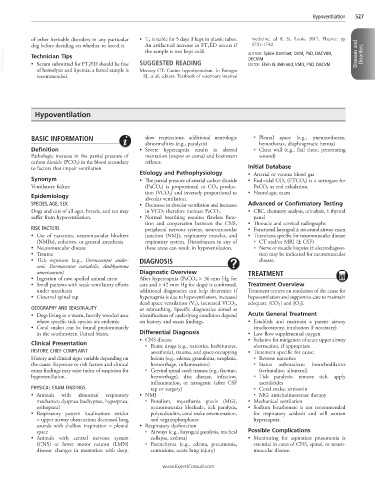Page 1064 - Cote clinical veterinary advisor dogs and cats 4th
P. 1064
Hypoventilation 527
of other heritable disorders in any particular • T 4 is stable for 5 days if kept in plastic tubes. medicine, ed 8, St. Louis, 2017, Elsevier, pp
dog before deciding on whether to breed it. An artifactual increase in FT 4 ED occurs if 1731-1742.
VetBooks.ir Technician Tips SUGGESTED READING AUTHOR: Sylvie Daminet, DVM, PhD, DACVIM, Diseases and Disorders
the sample is not kept cold.
DECVIM
• Serum submitted for FT 4 ED should be free
EDITOR: Ellen N. Behrend, VMD, PhD, DACVM
of hemolysis and lipemia; a fasted sample is
recommended. Mooney CT: Canine hypothyroidism. In Ettinger
SJ, et al, editors: Textbook of veterinary internal
Hypoventilation
BASIC INFORMATION slow respirations; additional neurologic ○ Pleural space (e.g., pneumothorax,
abnormalities (e.g., paralysis) hemothorax, diaphragmatic hernia)
Definition • Severe hypercapnia results in altered ○ Chest wall (e.g., flail chest, penetrating
Pathologic increase in the partial pressure of mentation (stupor or coma) and brainstem wound)
carbon dioxide (PCO 2 ) in the blood secondary reflexes.
to factors that impair ventilation Initial Database
Etiology and Pathophysiology • Arterial or venous blood gas
Synonym • The partial pressure of arterial carbon dioxide • End-tidal CO 2 (ETCO 2 ) is a surrogate for
Ventilatory failure (PaCO 2 ) is proportional to CO 2 produc- PaCO 2 at end exhalation.
tion (VCO 2 ) and inversely proportional to • Neurologic exam
Epidemiology alveolar ventilation.
SPECIES, AGE, SEX • Decreases in alveolar ventilation and increases Advanced or Confirmatory Testing
Dogs and cats of all ages, breeds, and sex may in VCO 2 therefore increase PaCO 2 . • CBC, chemistry analysis, urinalysis, ± thyroid
suffer from hypoventilation. • Normal breathing requires flawless func- panel
tion and cooperation between the CNS, • Thoracic and cervical radiographs
RISK FACTORS peripheral nervous system, neuromuscular • Functional laryngeal ± structural airway exam
• Use of narcotics, neuromuscular blockers junction (NMJ), respiratory muscles, and • Titers/tests specific for neuromuscular disease
(NMBs), sedatives, or general anesthesia respiratory system. Disturbances in any of ○ CT and/or MRI (± CSF)
• Neuromuscular disease these areas can result in hypoventilation. ○ Nerve or muscle biopsies (± electrodiagnos-
• Trauma tics) may be indicated for neuromuscular
• Tick exposure (e.g., Dermacentor ander- DIAGNOSIS disease.
soni, Dermacentor variabilis, Amblyomma
americanum) Diagnostic Overview TREATMENT
• Ingestion of raw, spoiled animal meat After hypercapnia (PaCO 2 > 36 mm Hg for
• Small patients with weak ventilatory efforts cats and > 42 mm Hg for dogs) is confirmed, Treatment Overview
under anesthesia additional diagnostics can help determine if Treatment centers on resolution of the cause for
• Cisternal spinal tap hypercapnia is due to hypoventilation, increased hypoventilation and supportive care to maintain
dead space ventilation (V d ), increased VCO 2 , adequate [CO 2 ] and [O 2 ].
GEOGRAPHY AND SEASONALITY or rebreathing. Specific diagnostics aimed at
• Dogs living in a warm, heavily wooded area identification of underlying condition depend Acute General Treatment
where specific tick species are endemic on history and exam findings. • Establish and maintain a patent airway
• Coral snakes can be found predominately (tracheostomy, intubation if necessary).
in the southeastern United States. Differential Diagnosis • Low flow supplemental oxygen
• CNS disease • Sedation for mitigation of acute upper airway
Clinical Presentation ○ Brain: drugs (e.g., narcotics, barbiturates, obstruction, if appropriate
HISTORY, CHIEF COMPLAINT anesthesia), trauma, and space-occupying • Treatment specific for cause:
History and clinical signs variable depending on lesions (e.g., edema, granuloma, neoplasia, ○ Reverse narcotics
the cause. Exposure to risk factors and clinical hemorrhage, inflammation) ○ Status asthmaticus: bronchodilators
exam findings may raise index of suspicion for ○ Cervical spinal cord: trauma (e.g., fracture, (terbutaline, albuterol)
hypoventilation. hemorrhage), disc disease, infection, ○ Tick paralysis: remove tick, apply
inflammation, or iatrogenic (after CSF ascridicides
PHYSICAL EXAM FINDINGS tap or surgery) ○ Coral snake: antivenin
• Animals with abnormal respiratory • NMJ ○ MG: anticholinesterase therapy
mechanics: dyspnea (tachypnea, hyperpnea, ○ Botulism, myasthenia gravis (MG), • Mechanical ventilation
orthopnea) neuromuscular blockade, tick paralysis, • Sodium bicarbonate is not recommended
• Respiratory pattern localization: stridor polyradiculitis, coral snake envenomation, for respiratory acidosis and will worsen
= upper airway obstruction; decreased lung and organophosphates hypercapnia.
sounds with shallow inspiration = pleural • Respiratory dysfunction
space ○ Airways (e.g., laryngeal paralysis, tracheal Possible Complications
• Animals with central nervous system collapse, asthma) • Monitoring for aspiration pneumonia is
(CNS) or lower motor neuron (LMN) ○ Parenchyma (e.g., edema, pneumonia, essential in cases of CNS, spinal, or neuro-
disease: changes in mentation with deep, contusions, acute lung injury) muscular disease.
www.ExpertConsult.com

